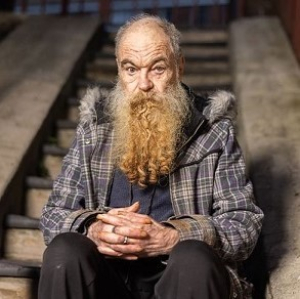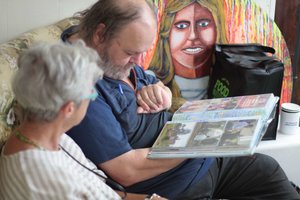Peter MALONE
All You Need is Crime
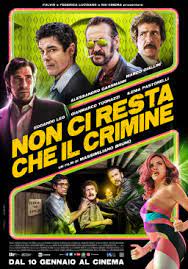
ALL YOU NEED IS CRIME
Italy, 2019, 105 minutes, Colour.
Alessandro Gassmann, Marco Giallini, Eduardo Leo, Gianarco Tognazzi, Ilenia Pastorelli, Massimiliano Bruno.
Directed by Massimiliano Bruno.
Here is a variation on Back to the Future (actually somebody says this in the film), Italian slacker style. It is often amusing in its way – but, rather silly. However, it was popular in its time and the director and cast made two more films, one continuing the present story, pursuing the woman who took all the money, the second another time travel but this time back to September 1943 and World War II.
In 2018, a group of friends from childhood have a scam going, advertising tours in Rome of all the scenes of crimes. They have their problems of employment, marriage and divorce… But, they know all the details of crime locations.
Then, to their surprise and ours, they go through a time portal landing in 1982, at the time of the World Cup, but right in the middle of the gangsters whose sites they intended to guide people to in 2018! The three friends are rather caricatures, but using the knowledge of the games in the World Cup to win a lot of money, cosying up to the gang leaders, an unpleasant crew, but the leaders, especially one, played by Eduardo Leo, taking a hostage. There are complications with the leader’s girlfriend who takes a shine to Sebastiano, Alessandro Gassman. But, from 2018, they have an idea about which church the hidden treasure in gold has been concealed and they are after that.
Italian comedy, comic characters and situations, amusing dialogue where in 1982 the three are referencing later inventions including mobile phones, the Internet… Even confronting their childhood selves, and a friend who has made a lot of money selling an app he invented, and the explanation given that one had taken the mobile phone through the tunnel and given it to the younger version of the inventor! And identifying himself as Steve Jobs!
Definitely just a light pastime, Italian style.
SuperFly/ 2018

SUPERFLY
US, 2018, 116 minutes, Colour.
Trevor Jackson, Jason Mitchell, Michael Kenneth Williams, Lex Scott Davis, Jennifer Morrison, Esai Morales, Kaalan Walker.
Directed by Director X.
The original Superfly from 1972 was part of the very popular exploitation era of American filmmaking, featuring African-American stars like Fred Williamson, Richard Rountree, Pam Grier… Super fly featured Ron O’Neal and Julius Harris. They were tough, assertive for African-American presence on screen, had quite a following amongst African-American audiences but beyond. The very much part of the culture of the time.
In later years, there were some attempts to revive the black split in genre, especially with Samuel L Jackson in the 2000 Shaft. This version of Super fly is another attempt, moderately popular with audiences, not receiving much critical acclaim. It takes advantage of 21st-century greater openness on screen in terms of violence, sexual activity, language.
It follows the same basic plot, drug dealers, dealers wanting to get out of the game, partners, doublecrossing, corrupt police, glamorous girlfriends… The star is Trevor Jackson, best known for 87 episodes of Grown-ish, along with Michael Kenneth Williams. The director is Director X, director of many music videos, some including Trevor Jackson.
Not necessary viewing except for those doing a history of blaxploitation films.
Chokehold/ Bogo Bogo

CHOKEHOLD/ BOGO BOGO
Turkey, 2023, 115 minutes, Colour.
Kivan Tatlitug, Funda Erygit.
Directed by Onur Saylak.
This is a Turkish film with universal application. It is set in a town on the Aegean and a remote farm.
Initially, the central character, Yalin, arriving at the farm with his wife and settling there, seems a sympathetic character. Gradually the truth is revealed about his background, his setting up of a Ponzi scheme, his partners and betrayal, the discovery, his evading the law and coming to the town.
He seems to be settling in when he is accosted in an antique shop by the salesman, one of his victims, a strong altercation, Yalin violent and killing the men, taking his body and burying it in secret. Later there is another confrontation, another killing, another burial.
Yalin becomes more restless, a touch paranoid with people observing him, going to a fishing group and promising to pay if they will take him to Greece. He has been tense with his wife, urging her to pack for their journey – and she revealing that it was she who gave the information about him to the authorities. And he responds violently.
There is something of a cynical ending, Yalin giving the money to the authorities and their accepting it, letting him go free – and the possibility of his setting up another Ponzi scheme.
- Title? Physical chokehold? Moral chokehold?
- The Turkish story, finance and business? Ponzi schemes? Exploitation? Responsibility and guilt? The law, evading the law? Universal story?
- The location, the town, the farm, isolated, the Aegean Sea, shops, police precincts? Authentic feel? Musical score?
- The initial response to Yalin, presentable, competent, taking up residence at the farm, his relationship with his wife, her support? Audience empathy?
- The gradual revelation of the truth, Yalin and his business, his colleagues, doublecross, the Ponzi scheme, taking the money from poor people, hiding the money, arrest, evading the law, coming to the farm for isolation? The role of his wife, support, her knowledge of what was happening? The later revelation that she had informed on him to the authorities?
- The surprise of the sequence with Yalin going to the shop, to buy the gift, the encounter with the salesman, the attack, the victim of the scheme, Yalin’s violence, killing the man, taking his body, burying it? The enquiries by the police? His covering story?
- His becoming more and more morose, interactions with his wife, isolated, the second man attacking him, the second killing, burying the body?
- People observing him, the fishing crew, his going to the wharf, the young man, the plan to come with the money, to sail to Greece?
- The encounter with his wife, the relationship, her revealing the truth, his violence towards her? The initial burying of the money, recovering the barrel, the amount of money?
- Yalin, the violence towards his wife, his reaction to her betrayal, the police investigation, his giving them the money, their accepting it, letting him go free?
- Settling in the town – and the possibility of his setting up a further scheme and exploitation?
- The film as a critique of exploitation financial schemes and the oppression of poor subscribers?
Carnifex
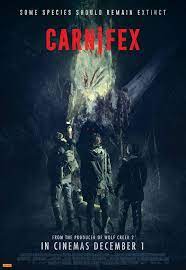
CARNIFEX
Australia, 2022, 93 minutes, Colour.
Alexandra Park, Sisi Stringer, Harry Greenwood.
Directed by Sean Lahiff.
Carnifex is not a frequently used word. As explained in the screenplay, the executioner in Roman times was called the Czrnifex, and the word extended to killing and meat grinding.
This film was made in the forests of South Australia, with some beautiful photography of the forest, the trees, and the range of animals and birds in the forest. The first hour of the film focuses on three young adults in the forest, one working with video to make a film about the work of the other two, their care for the animals, their knowledge, preservation, setting up cameras through the forest to record animal movement. The three get on well together. Which means that the first part of the film is interesting for those who are concerned about animal conservation.
However, there is an interview with a ranger, rather offhand in his manner, practising his golf while alone. There is also a hunter who is attacked by a mysterious creature.
The last part of the film has the animal menace, the audience aware of the attack on the hunter, the gradual awareness of the creature, suggested rather than seen full on, his attack on the young man of the group, the menace to the two women, their taking refuge in a truck with the dog of the hunter, the crash over a cliff, recovery, a rifle, the destruction of the creature.
For those eager to see animal horror, their patience will be tested because of the first hour with its conservation themes and then the horror is more of suggestion rather than blood and gore. For those interested in animal conservation – with a touch of animal horror, they might identify better with this film.
- The title? The exclamation? The executioner, ancient Rome? Forest creature? Extension or not?
- South Australian forest settings, the beauty of the forest, the range of animals and birds, day sequences, night sequences? The musical score?
- Audiences identifying with the central characters, in their 20s, jobs, video filming, animal protection in the forests, the interview with the ranger, the scene of the Hunter? The drive into the forest, the filming, Bailey and her work, Grace and her knowledge, commentary, Ben and his work, commentary? The bonds between the three?
- The aftermath of the vast forest fire, the fire during the credits, the scenes of the destroyed forest? The cameras in the forest, alerted by movement and sound, the group checking on the cameras, watching the filming?
- The bulk of the film with its conservation and animal preservation theme? The suggestion of menace? The hunter, his dog, the attack and his death?
- The night, the discovery of the claws, the creature climbing trees, meat eating, destructive? Ben and his explanations?
- The attack, Ben, defending himself, death?
- Grace, falling down the cliff, talking with Ben, climbing, to the truck, meeting up with Bailey? The dog?
- Bailey, filming, the menace, the dog, going to the truck? With Grace, driving, going down the cliff, the menace? The rifle? Waiting, shooting the creature?
- The end, emerging from the forest? The combination of conservation and animal menace?
Sweet As
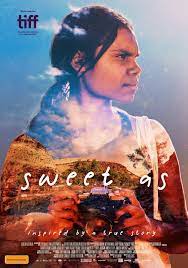
SWEET AS
Australia, 2022, 87 minutes, Colour.
Shantae Barnes-Cowan, Tasma Walton, Carlos Sanson, Mark Coles Smith, Ngaire Pigram, Pedrea Jackson, Mikayla Levy, Andrew Wallace.
Directed by Jub Clerc.
For Australian audiences, as well as overseas audiences, this film is an invitation to explore Western Australia, Pilbara country. And we are invited to share the experience with four troubled teenagers who go on an organised safari with two supervisors, an opportunity for them to get away from their surroundings, face some of their own problems. But, the key is for each of the four to have a camera, to take photos of their choice, creating stories with their photos, coming to some kind of self-appreciation and self-understanding.
The central youngster in this story is Murra, played attractively and more than competently by Shantae Barnes-Cowan who has already shown a talent for acting in film and television. She is at school. She indulges in some shoplifting. Her mother, a drinker, is highly critical of her and some of the drinkers in the house tried to molest her. Fortunately, she has a sympathetic uncle, a local policeman, Ian, played by the ever-reliable Mark Coles Smith. It is he who gets her a place on the minibus for the camera safari. She is joined by three other youngsters, Sean, pale and thin, depressed and sometimes feeling suicidal; Elvis, aboriginal boy who suffered the trauma of being beaten up but still has a lively personality; Kylie, white girl, dominated by an adult white male, surly. But, the chaperones on the trip are very sympathetic, Tasma Walton is a no-nonsense driver and advisor, Carlos Sanson Jr is the photography expert (explaining himself as Fernando, Nando, exiled from Nicaragua with his photographer mother and academic father, Carlos Sanson Jr coming from Sydney but with Cuban-Chilean background).
Dramatically, there are not too many surprises along the way. But, that is not the point. The point is to look at the portrait of the four, sense their inadequacies, see their limitations, even in relating to each other, the false steps they take, the clashes, their being left to fend for themselves in the bush, the responding to some crises, and the photographs.
Murra finds that photography is one of her talents, carefully choosing pictures, and the audience seeing the title at the side of each photo she takes. She is on country and we observe country through her eyes, the extraordinary beauty of the rock formations, the water holes and waterfalls…
So, on the whole, this is a sweet film, not a dramatic blockbuster! There is a great sense of humanity. And, in the year of the referendum and The Voice, a visit to indigenous families, hardships, violence, drinking, family neglect – no privileges there. The Voice is an appeal to better First Nations conditions.
- The title, the tone? In relationship to the central characters? The safari, photography?
- The location photography, the Pilbara, the towns, houses, the open roads, the mines, the trains, the beauty of nature, the rock formations, red colour, water holes, waterfalls…? The musical score?
- The introduction to Murra, aboriginal girl, age, experience school, the shoplifting scene, home life, barring the door, her mother and drinking, her mother neglecting her, the visitors, the attempt to molest her, her mother’s reaction, Murra going to her uncle, her uncle the policeman, concern, handcuffing the mother, the uncle taking Mara for the safari? Her unwillingness?
- The safari in the organisation, Mitch, strong personality, interactions with the youngsters, with Nando, driving, discipline, sympathy? Nando, the Nicaraguan background, his parents, photography, his skills, friendliness? The supervision, chaperones?
- The four youngsters, Murra and her keeping apart, Sean, thin, white, his mother and family, their concern, his revealing that he felt suicidal? Kylie, with the adult man, the phone, his demands that she contact him, her surly attitudes? Elvis, family, cheerful?
- A road film, the variety of locations, in the town, the large ships and the port, the hills and chemicals, the open road?
- The interactions amongst the four, their being given the cameras, their skills and lack of skills in photography, Nando urging them to photograph choices, giving the photos titles, Murra and her stories with the photos? The photographing each other? The two girls, tensions, black and white, different kinds of surliness? The two boys, Elvis and his liveliness, Sean withdrawn? The motel, Murra getting the drink, the four drinking, the men and their approaches? Mitch and Nando and bringing the group back?
- Out in the country, pitching the tents, rivalries, clashes? The walks out in the countryside, the beauty of the countryside, Murra, going into the water, the seductive eye toward Nando, his reaction? Losing Sean? Everybody searching for him, Murra retracing the steps, finding him on the edge of the cliff, throwing the torch over, bringing him back?
- Each of the group telling their stories, their problems, self-understanding, self-deprecation?
- Their being left to themselves, Elvis and the hunting, the scrub turkey, the meal, Murra explaining the berries…? The bonding?
- The return home, the effect of the safari, the photos, the family is waiting for them, Kylie asserting herself against the man, Murra and the reconciliation with her mother, the support of her uncle, Sean and his family, Elvis and his family?
- The coming-of-age themes, problem children, facing issues, photography therapy, the results?
- The cinema contribution to indigenous stories?
Mother's Day/ 2023
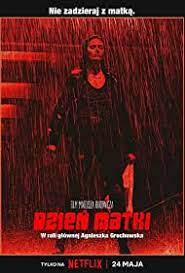
MOTHER’S DAY
Poland, 2023, 93 minutes, Colour.
Agnieszka Grochowski, Adrian Delikta, Darius Chojnacki, Paulina Chrusciel, Pawel Koslik, Szymon Wroblewski.
Directed by Mateusz Rakowicz.
It must have been the zeitgeist of 2022-2023 but Netflix released two films at much the same time, The Mother with Jennifer Lopez, the Polish film, Mother’s Day, with Agnieszka Grochowski. They have similar themes, tough women who have served in special operations, their child abducted, their going to the rescue, bringing to bear all their skills in fighting and martial arts.
They both have the kind of plot that reminds audiences of Liam Neeson and the Taken series. These two films might make Liam Neeson somewhat envious!
We are introduced to Nina, retired from Special Ops for 20 Years, working the crane on the disposed cars yard, allegedly dead, visiting her gravestone in the cemetery. She does get involved, on Mother’s Day, with a group of toughs, illustrating her skills – but, in all her work and fights, being wounded, always vulnerable. She has given up her son for adoption but watches him in his adoptive family through her binoculars.
She becomes exposed, the target of thugs who want to capture her – and one of the oddest psychopaths on screen played by Szymon Wroblewski. However, while she rescues her son, she is tricked, wounded, and her son in the power of hostile authority. There is a twist in the plot when her government confidante is revealed as setting up the whole plot for money and care of his daughter.
Plenty of fights – and happy ending
- The title? The background of the celebration in Poland? The scenes of mothers, Nina, Max and his adoptive mother?
- The Polish crime and action show, the popularity of these films in the 2020s?
- Nina’s story, her background, NATO and Special Ops, her technical skills, martial arts skills? 20 years earlier, the clashes with the Serbians, her relationship with her husband, his ethnic background, their son, giving up for adoption, her disappearing, the visit to the cemetery and her gravestone? Her working with the crane with the used cars? No personal life? The introduction, the talking young men, immediately going into fighting them? Yet her own injuries?
- The situation with Igor, his knowing her background, the visit to the cemetery, the discussions, keeping her cover? The later revelation of his betrayal, his money motivation, connection with the woman who was boss, the government meeting, the accusations against him, in the car, the guns, the crash, the confrontation with Nina?
- Max, his age, adopted, relationship with his adoptive parents, their care for him? Nina, watching the family through the binoculars? Igor and his criticisms?
- The Serb background, tracking down Nina, the group of thugs, Tytus and his failures, Woltomiertz, his position, what he was wearing, the orgies atmosphere, the electricity, his attack on Titus, killing him? His relationship with a gang? The going out to confront Nina, the fights, her defeating so many of the attackers, the confrontation with Woltomeirtz, the electricity, standing her, the fight and her killing him?
- The higher authorities, the older woman, memories of the past, the consultations, the phone calls, orders? The abduction of Max?
- Max, his being abducted, held, Nina finding him, his suspicions, reactions? Her hiding him? Her fights, his watching?
- Max being taken, with the older woman, Nina coming, the discussions, her taking Max away?
- Igor, the revelation about the scenario, to pursue Nina? And the haunted money, the police, Igor taking it?
- Nina, revealing the truth to Max, the box with the photos, delivering him home, the response of the parents? And her later visits? The possibility for her future?
Covid-delayed celebrations, Tan Nguyen MSC, 20 years ordained
Covid-delayed celebrations, Tan Nguyen MSC, 20 years ordained

Paul Cashen writes of Tan’s 20th anniversary (delayed due to Covid).
On the 20th Anniversary of Tan’s ordination, 250 people gathered at the church at Pooraka. Apart from Peter, the two Pauls from Adelaide, there were priest friends from Sydney also, including the POW chaplain Fr Thang MSC.

The Mons. Minh-Tam Nguyen has known Tan as an altar boy and he built the Church of Our Lady of The Boat People opened four years ago, it holds 2000 people, and is next door is a community arena which was a big as the church… Tan was ordained and celebrated his “first mass” there. Congratulations to Tan and his parents and family, We thank him also for being a significant member of the Adelaide Community through COVID19.

Midweek Province photos.
Midweek Province photos.
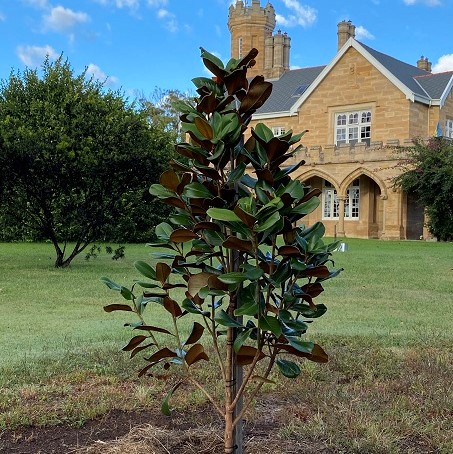
This tree was the symbol at our Chapter and was then transplanted at St Mary’s Towers, symbol of growth.
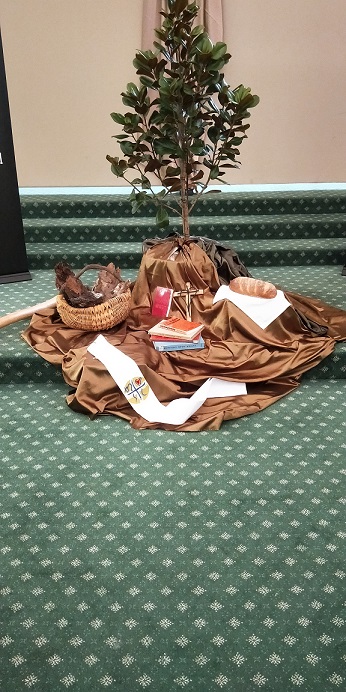
Then, recently, with Laudato si motivation, parishioners planted trees – seen with Fred Stubenrauch.
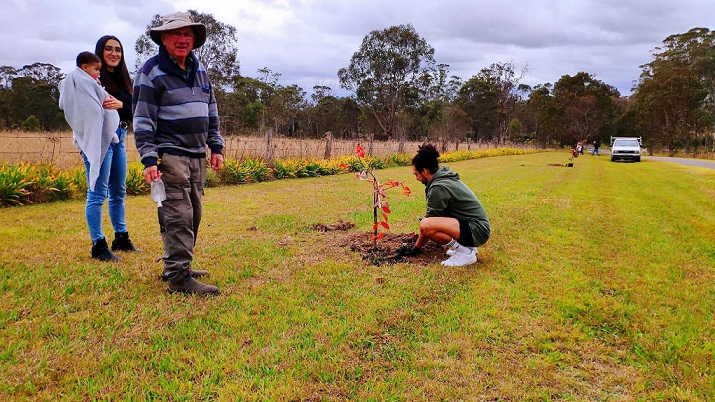
Meanwhile at St Mary’s Towers, Josef Senjuk turned 70.

But, at Kensington, Noel Mansfield is 90.
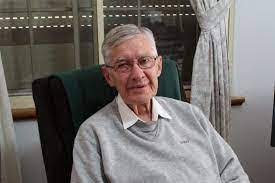
And, visions of Kensington, courtesy of John Walker and his camera, the Monastery and rainbow seen from the OLSH convent.
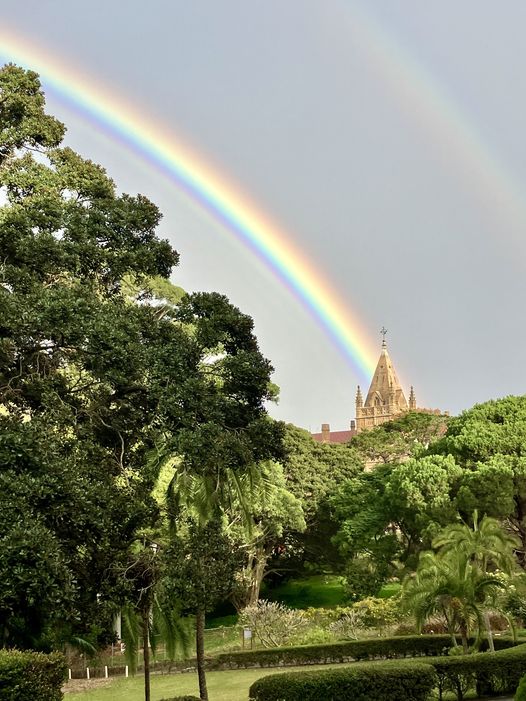
Recently at Daramalan,
- MSC Schools: The MSC Schools’ Company Meeting and A.G.M. were held earlier this week at Daramalan College. The following attended:
o Members of the MSC Education Members Council (EMC)
o Members of the MSC Education Committee
o The School Principals
o Chair of the School Boards
o Assistant Principal Mission from each school, and,
o Business Managers.
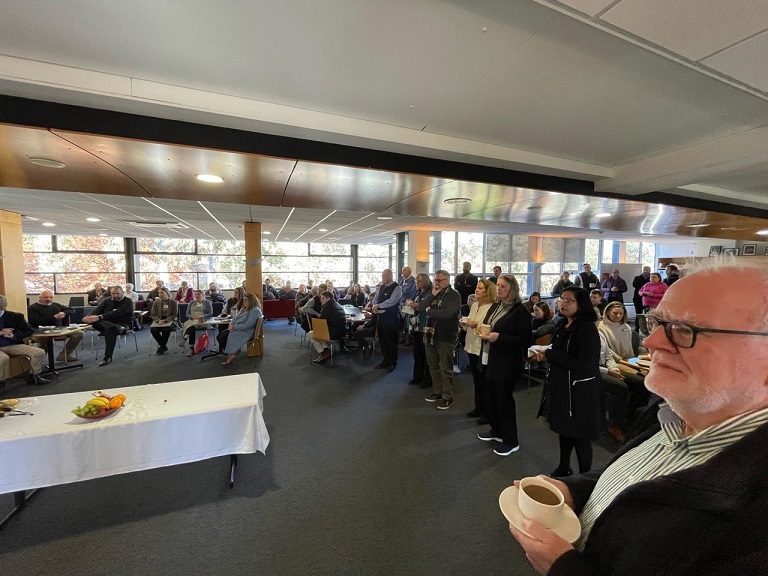
It was an opportunity to farewell Anne Benjamin and Phil Fitzgerald who were inaugural members of the EMC. Chris was also farewelled, as this was his last meeting, with moving words spoken by Rachel Davies (principal of Daramalan College). Meta Jackman presented Professional Standards and Safeguarding issues. Thank you to Mark McGinnity for the smooth running of the three days.
David’s Place poet launches new book on street spirituality, Redemption at Work: My Life Story
David’s Place poet launches new book on street spirituality, Redemption at Work: My Life Story
Marilyn Rodrigues Catholic Weekly May 31, 2023 Sent by Claude Mostowik MSC, Province Justice and Peace Office.
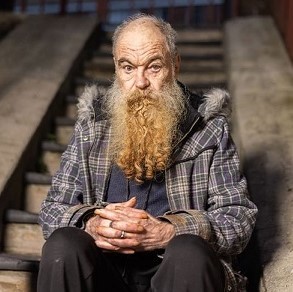
Street poet David Marsh with his seventh book, a memoir titled Redemption at Work: My life story. Photo: Alphonsus Fok
Street poet David Marsh launched his seventh book, a memoir titled Redemption at Work: My life story, at St Canice’s Church, Elizabeth Bay, on 27 May.
Mr Marsh, 66, has lived on or near the streets of inner and south Sydney for much of his life, which he chronicled in his previous books of poetry, prayers and reflections.

David’s place is an inner city space where Sydney's
homeless and MARGINALISED can come to find
friendship, peace, spiritual NOURISHMENT
and connect with the wider community.
It was created to be a place where Jesus would have liked to hang out,
where it doesn't matter if you're rich or poor, or where life has led you.

Photo: Australian Catholics
He is a long-time member of David’s Place, a spiritual and fellowship community supported by the Archdiocese of Sydney and St Canice’s.
Attracted to a career in politics or law in his youth, Mr Marsh told the gathering that he suffered the first of a series of mental breakdowns in his early 20s “at the end of my father’s fists.”
“When I was converted I was in a state where it was impossible for me to find any sort of positivity in my life,” he said.
“My conversion changed all that and Jesus was the first hope that I had of recovery from mental illness.
“My recovery is what I’m most grateful for in my life, that and the standing I have in the community today after being rejected and despised in my early life.”
Mr Marsh publishes his poetry and other writings on his website, A Street Spirituality (although the site is currently down).
He says that prayer is the lynchpin of his creative life and told The Catholic Weekly he considers his litanies to be the pinnacle of his work.
Some of them have been given a nihil obstat and imprimatur—declarations that they are free from doctrinal or moral error and therefore suitable for public or private prayer.
“I know that my life has been of value to people. Part of the reason I wrote the book is that my life would be known to people and I hope it will be of value,” he said.
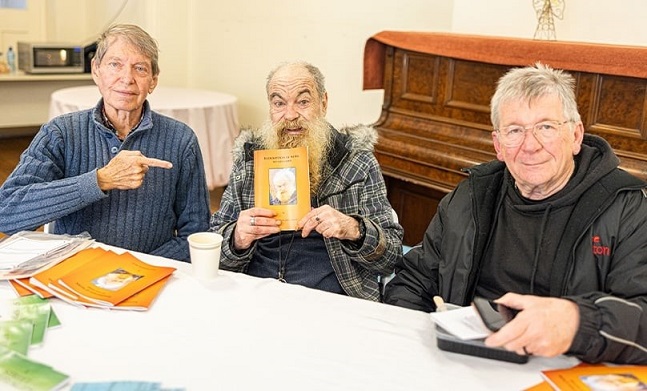
Street poet David Marsh launched his book at St Canice’s Church, Elizabeth Bay, with Bishop Daniel Meagher, his family and his friends on 27 May. Photo: Alphonsus Fok
“I chose the title Redemption at Work in order to emphasise what I see: Christ’s redemption at work in the story.”
Fr Claude Mostowik MSC launched the book, and said that all of the poet’s writings “come very much from the heart.”
He spoke of the influence of various Christian communities Mr Marsh has inhabited and enriched.
“David’s book has not been written in a vacuum,” he said.
Fr Mostowik paid tribute to the late Sr Pauline Fitz-Walter SGS, Fr Brian Stoney SJ and others who, “in their companionship and guidance and kindness along with many others walked with people … who are considered non-people or not important.”

“I couldn’t help reading this book as if it might be the life story of many people in our community, who have been shunned, rejected and considered nuisances.
“David seems to be speaking for them as well, not only for himself.
“These wounds reveal in David an openness, a connection, a resilience, a strength and compassion for others which has made connection with other people possible.
“He has provided us with deeply human stories of his life without possessions but with the forgiveness offered by Jesus.”
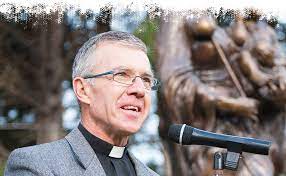
The book launch was preceded by Mass celebrated by Bishop Daniel Meagher, Fr Claude Mostowik MSC and Fr Isaac Koi, and attended by David’s Place facilitator Sue Buckingham and members of their community, Mr Marsh’s family, friends and supporters.
Being Mary Tyler Moore
BEING MARY TYLER MOORE
US, 2022, 119 minutes, Colour.
Directed by James Adolphus.
 For audiences who have admired television on screen star, Mary Tyler Moore, prominent from the 1960s, especially on television, The Dick Van Dyke Show and The Mary Tyler More Show, this documentary serves as a biography, and admiring portrait, a summary of her career with a considerable number of excerpts from her shows illustrating her versatility, her verve, with testimonies from members of the cast of each show, from writers and producers like Carl Reiner and James L. Brooks, and testimonies from later comedians who speak with admiration and gratitude. To that extent, this documentary serves as a significant record.
For audiences who have admired television on screen star, Mary Tyler Moore, prominent from the 1960s, especially on television, The Dick Van Dyke Show and The Mary Tyler More Show, this documentary serves as a biography, and admiring portrait, a summary of her career with a considerable number of excerpts from her shows illustrating her versatility, her verve, with testimonies from members of the cast of each show, from writers and producers like Carl Reiner and James L. Brooks, and testimonies from later comedians who speak with admiration and gratitude. To that extent, this documentary serves as a significant record.
The film also shows the personality of Mary, the background of her family, tension with relationships in her family, a love of performing, success in getting jobs, commercials, television shows, auditioning for the Dick van Dyke show, success, Emmy awards, her own show, her company, MTM, her brief marriage when young, her marriage to Grant Tinkler who managed her company and then the surprise of her divorce from him after 18 years. It may have been hinted at but audiences may find it a surprise to find that she went to the Betty Ford clinic in her late 40s with alcohol problems. Breaking with the West Coast, she had success on the Broadway stage in Whose Life is it Anyway? And then an Oscar nomination for Ordinary People. She encountered a younger doctor, fell in love, remained married to him for over 30 years. There is a lot of footage from the time of this marriage and testimonies from her husband who served as an executive producer of this documentary.
But, there is an underlying thesis in the film which makes it of interest culturally, American culturally. It concerns the place of women in American society, the presuppositions of the wife and mother in the 1950s and earlier, the shifts in the 1960s and more openness, especially exemplified in the characters played by Mary Tyler Moore in both series. The case for her strong influence in changing attitudes of ordinary American women, the viewers of her television shows, is made very strongly, discussions about feminism, Betty Friedan, references to Gloria Steiner.
Which means then that the documentary will remain a significant contribution to the influence of popular American television in the 20th century.


